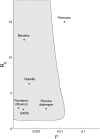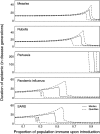Epidemic enhancement in partially immune populations
- PMID: 17225866
- PMCID: PMC1769520
- DOI: 10.1371/journal.pone.0000165
Epidemic enhancement in partially immune populations
Abstract
We observe that a pathogen introduced into a population containing individuals with acquired immunity can result in an epidemic longer in duration and/or larger in size than if the pathogen were introduced into a naive population. We call this phenomenon "epidemic enhancement," and use simple dynamical models to show that it is a realistic scenario within the parameter ranges of many common infectious diseases. This finding implies that repeated pathogen introduction or intermediate levels of vaccine coverage can lead to pathogen persistence in populations where extinction would otherwise be expected.
Conflict of interest statement
Figures



References
-
- Kermack WO, McKendrick AG. A contribution to the mathematical theory of epidemics. Proc R Soc London Ser A. 1927;115:700–721.
-
- Anderson RM, May RM. The invasion, persistence and spread of infectious diseases within animal and plant communities. Philos Trans R Soc London Ser B. 1986;314:533–568. - PubMed
-
- Diekmann O, Heesterbeek JAP, Metz JAJ. On the definition and the computation of the basic reproduction ratio R0 in models for infectious diseases in heterogeneous populations. J Math Biol. 1990;28:365–382. - PubMed
Publication types
MeSH terms
Substances
Grants and funding
LinkOut - more resources
Full Text Sources
Medical
Miscellaneous

